Detailed Analysis of Consumer Purchase Behavior: Marketing Report
VerifiedAdded on 2020/03/02
|18
|3879
|32
Report
AI Summary
This report provides a comprehensive analysis of consumer behavior, focusing on the purchase decisions of a single customer over a week. It examines the differences in buying patterns between high and low involvement products, highlighting factors such as price, frequency of purchase, and the level of information search undertaken by the consumer. The study identifies that low involvement products, like groceries and daily necessities, lead to quick decisions based on habit and convenience, with minimal research. Conversely, high involvement products, such as an iPhone, prompt extensive research and careful consideration due to their higher cost and less frequent purchase. The report includes a detailed description of the consumer's demographics, psychographics, and personality traits, providing context for their purchasing behavior. It maps consumer insights, analyzes the decision-making processes for both weekly and high-involvement purchases, and compares the approaches to these different product categories. Key insights derived from the analysis emphasize the importance of targeted marketing strategies tailored to the level of consumer involvement. The report concludes by summarizing the key findings and offering implications for marketing professionals seeking to understand and influence consumer behavior effectively.

1
Paraphrase This Document
Need a fresh take? Get an instant paraphrase of this document with our AI Paraphraser

Marketing
2
2
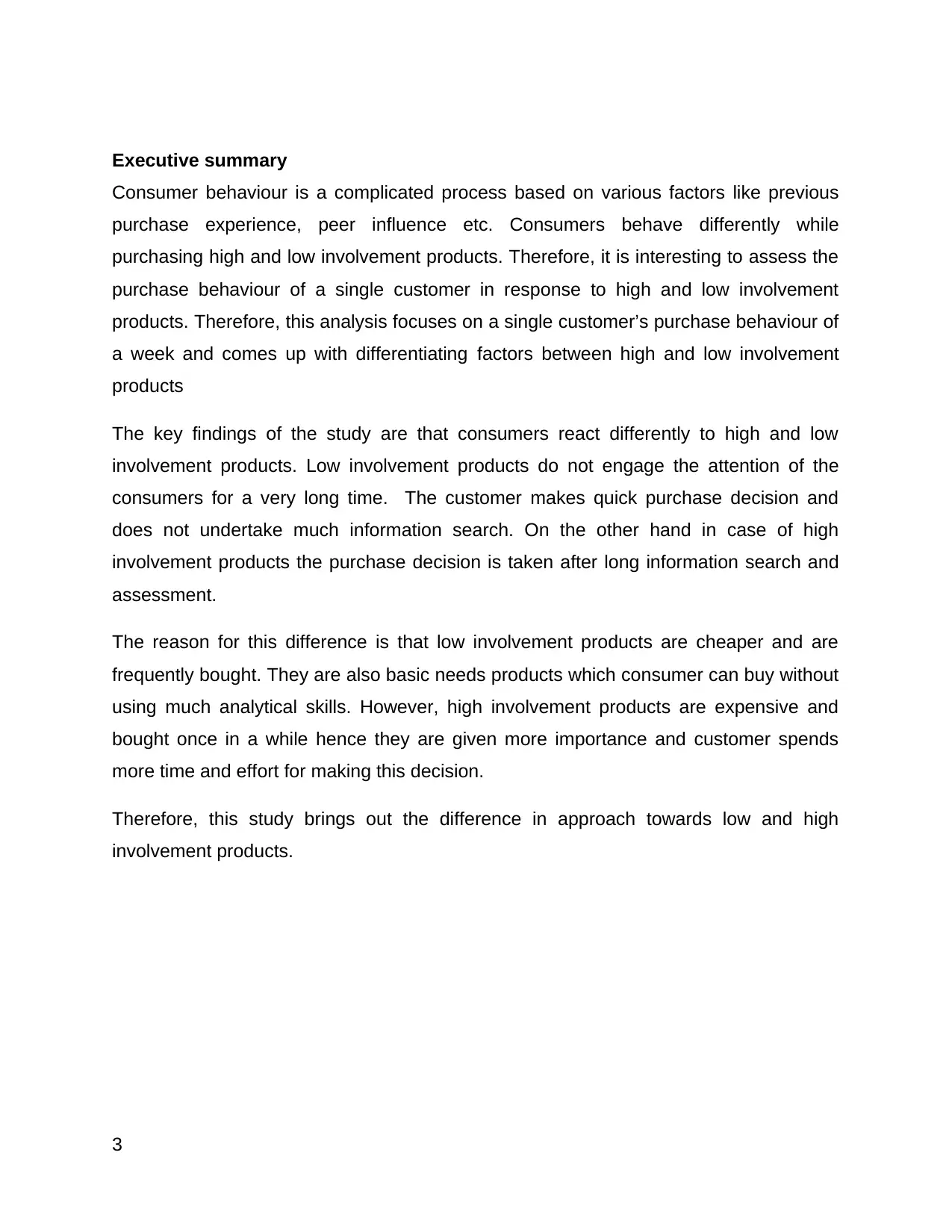
Executive summary
Consumer behaviour is a complicated process based on various factors like previous
purchase experience, peer influence etc. Consumers behave differently while
purchasing high and low involvement products. Therefore, it is interesting to assess the
purchase behaviour of a single customer in response to high and low involvement
products. Therefore, this analysis focuses on a single customer’s purchase behaviour of
a week and comes up with differentiating factors between high and low involvement
products
The key findings of the study are that consumers react differently to high and low
involvement products. Low involvement products do not engage the attention of the
consumers for a very long time. The customer makes quick purchase decision and
does not undertake much information search. On the other hand in case of high
involvement products the purchase decision is taken after long information search and
assessment.
The reason for this difference is that low involvement products are cheaper and are
frequently bought. They are also basic needs products which consumer can buy without
using much analytical skills. However, high involvement products are expensive and
bought once in a while hence they are given more importance and customer spends
more time and effort for making this decision.
Therefore, this study brings out the difference in approach towards low and high
involvement products.
3
Consumer behaviour is a complicated process based on various factors like previous
purchase experience, peer influence etc. Consumers behave differently while
purchasing high and low involvement products. Therefore, it is interesting to assess the
purchase behaviour of a single customer in response to high and low involvement
products. Therefore, this analysis focuses on a single customer’s purchase behaviour of
a week and comes up with differentiating factors between high and low involvement
products
The key findings of the study are that consumers react differently to high and low
involvement products. Low involvement products do not engage the attention of the
consumers for a very long time. The customer makes quick purchase decision and
does not undertake much information search. On the other hand in case of high
involvement products the purchase decision is taken after long information search and
assessment.
The reason for this difference is that low involvement products are cheaper and are
frequently bought. They are also basic needs products which consumer can buy without
using much analytical skills. However, high involvement products are expensive and
bought once in a while hence they are given more importance and customer spends
more time and effort for making this decision.
Therefore, this study brings out the difference in approach towards low and high
involvement products.
3
⊘ This is a preview!⊘
Do you want full access?
Subscribe today to unlock all pages.

Trusted by 1+ million students worldwide
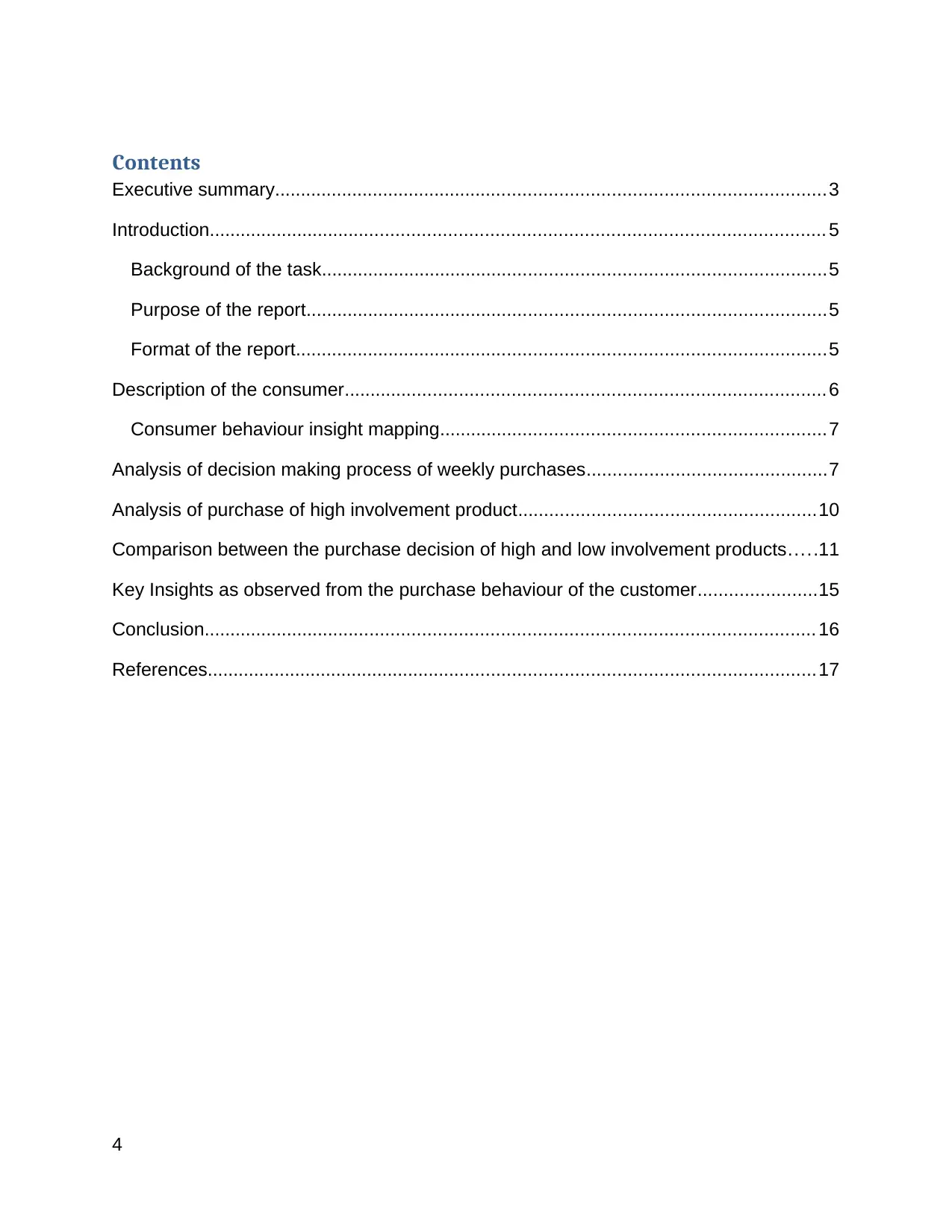
Contents
Executive summary..........................................................................................................3
Introduction...................................................................................................................... 5
Background of the task.................................................................................................5
Purpose of the report....................................................................................................5
Format of the report......................................................................................................5
Description of the consumer............................................................................................6
Consumer behaviour insight mapping..........................................................................7
Analysis of decision making process of weekly purchases..............................................7
Analysis of purchase of high involvement product.........................................................10
Comparison between the purchase decision of high and low involvement products.....11
Key Insights as observed from the purchase behaviour of the customer.......................15
Conclusion..................................................................................................................... 16
References.....................................................................................................................17
4
Executive summary..........................................................................................................3
Introduction...................................................................................................................... 5
Background of the task.................................................................................................5
Purpose of the report....................................................................................................5
Format of the report......................................................................................................5
Description of the consumer............................................................................................6
Consumer behaviour insight mapping..........................................................................7
Analysis of decision making process of weekly purchases..............................................7
Analysis of purchase of high involvement product.........................................................10
Comparison between the purchase decision of high and low involvement products.....11
Key Insights as observed from the purchase behaviour of the customer.......................15
Conclusion..................................................................................................................... 16
References.....................................................................................................................17
4
Paraphrase This Document
Need a fresh take? Get an instant paraphrase of this document with our AI Paraphraser

Introduction
Consumer behaviour is a discipline of management through which marketers try to
assess the consumer buying decisions (Ammi, 2013). Consumer behaviour assessment
assists in judging customer needs so that organisations can fulfil them accurately.
Background of the task
Overall purchase behaviour of a consumer differs depending upon the involvement level
of the products that consumer purchases (Blythe, 2013). An assessment of the
consumer buyer behaviour helps organisations in devising marketing strategies to target
consumers based on their decision making process (Armstrong, 2012) Therefore,
analysis of buyer behaviour is very important to business organisations. Study of
consumer behaviour classifies products as high and low involvement products (Close,
2012). Low involvement products are generally less expensive and frequently
purchased products. The time spent on decision making of purchase of such products is
low (East & Wright, 2013). However, high involvement products are expensive and
seldom bought products. The time and attention spent on such products is high (Hoyer,
2012). Therefore, consumer purchase decision and behaviour varies depending on
involvement level of the product.
Purpose of the report
The purpose of this report is to assess the overall decision making process of high and
low involvement products purchased by a customer during a particular week. This report
also intends to assess the process involved in purchase decision of a high involvement
product. Furthermore, the report will try to compare and contrast the difference in
purchase decision of high and low involvement products.
Format of the report
The Report follows business format. A single customer is described through this report
The report then discusses the low and high involvement purchase decisions of this
single customer. In continuation, the purchase decision of high and low involvement
products is compared. Further, insights gathered from the discussion are listed. Finally
conclusions are drawn based on the findings.
5
Consumer behaviour is a discipline of management through which marketers try to
assess the consumer buying decisions (Ammi, 2013). Consumer behaviour assessment
assists in judging customer needs so that organisations can fulfil them accurately.
Background of the task
Overall purchase behaviour of a consumer differs depending upon the involvement level
of the products that consumer purchases (Blythe, 2013). An assessment of the
consumer buyer behaviour helps organisations in devising marketing strategies to target
consumers based on their decision making process (Armstrong, 2012) Therefore,
analysis of buyer behaviour is very important to business organisations. Study of
consumer behaviour classifies products as high and low involvement products (Close,
2012). Low involvement products are generally less expensive and frequently
purchased products. The time spent on decision making of purchase of such products is
low (East & Wright, 2013). However, high involvement products are expensive and
seldom bought products. The time and attention spent on such products is high (Hoyer,
2012). Therefore, consumer purchase decision and behaviour varies depending on
involvement level of the product.
Purpose of the report
The purpose of this report is to assess the overall decision making process of high and
low involvement products purchased by a customer during a particular week. This report
also intends to assess the process involved in purchase decision of a high involvement
product. Furthermore, the report will try to compare and contrast the difference in
purchase decision of high and low involvement products.
Format of the report
The Report follows business format. A single customer is described through this report
The report then discusses the low and high involvement purchase decisions of this
single customer. In continuation, the purchase decision of high and low involvement
products is compared. Further, insights gathered from the discussion are listed. Finally
conclusions are drawn based on the findings.
5
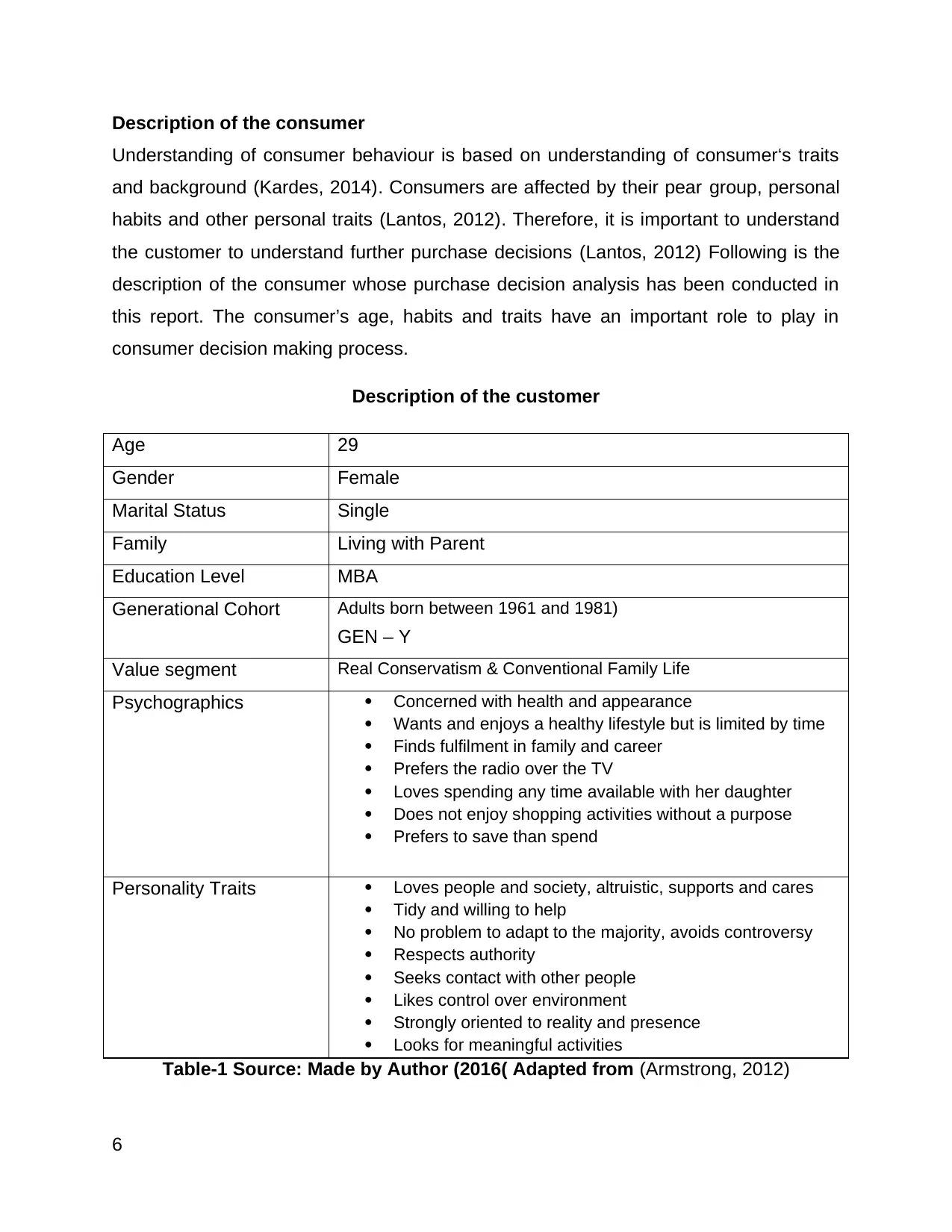
Description of the consumer
Understanding of consumer behaviour is based on understanding of consumer‘s traits
and background (Kardes, 2014). Consumers are affected by their pear group, personal
habits and other personal traits (Lantos, 2012). Therefore, it is important to understand
the customer to understand further purchase decisions (Lantos, 2012) Following is the
description of the consumer whose purchase decision analysis has been conducted in
this report. The consumer’s age, habits and traits have an important role to play in
consumer decision making process.
Description of the customer
Age 29
Gender Female
Marital Status Single
Family Living with Parent
Education Level MBA
Generational Cohort Adults born between 1961 and 1981)
GEN – Y
Value segment Real Conservatism & Conventional Family Life
Psychographics Concerned with health and appearance
Wants and enjoys a healthy lifestyle but is limited by time
Finds fulfilment in family and career
Prefers the radio over the TV
Loves spending any time available with her daughter
Does not enjoy shopping activities without a purpose
Prefers to save than spend
Personality Traits Loves people and society, altruistic, supports and cares
Tidy and willing to help
No problem to adapt to the majority, avoids controversy
Respects authority
Seeks contact with other people
Likes control over environment
Strongly oriented to reality and presence
Looks for meaningful activities
Table-1 Source: Made by Author (2016( Adapted from (Armstrong, 2012)
6
Understanding of consumer behaviour is based on understanding of consumer‘s traits
and background (Kardes, 2014). Consumers are affected by their pear group, personal
habits and other personal traits (Lantos, 2012). Therefore, it is important to understand
the customer to understand further purchase decisions (Lantos, 2012) Following is the
description of the consumer whose purchase decision analysis has been conducted in
this report. The consumer’s age, habits and traits have an important role to play in
consumer decision making process.
Description of the customer
Age 29
Gender Female
Marital Status Single
Family Living with Parent
Education Level MBA
Generational Cohort Adults born between 1961 and 1981)
GEN – Y
Value segment Real Conservatism & Conventional Family Life
Psychographics Concerned with health and appearance
Wants and enjoys a healthy lifestyle but is limited by time
Finds fulfilment in family and career
Prefers the radio over the TV
Loves spending any time available with her daughter
Does not enjoy shopping activities without a purpose
Prefers to save than spend
Personality Traits Loves people and society, altruistic, supports and cares
Tidy and willing to help
No problem to adapt to the majority, avoids controversy
Respects authority
Seeks contact with other people
Likes control over environment
Strongly oriented to reality and presence
Looks for meaningful activities
Table-1 Source: Made by Author (2016( Adapted from (Armstrong, 2012)
6
⊘ This is a preview!⊘
Do you want full access?
Subscribe today to unlock all pages.

Trusted by 1+ million students worldwide
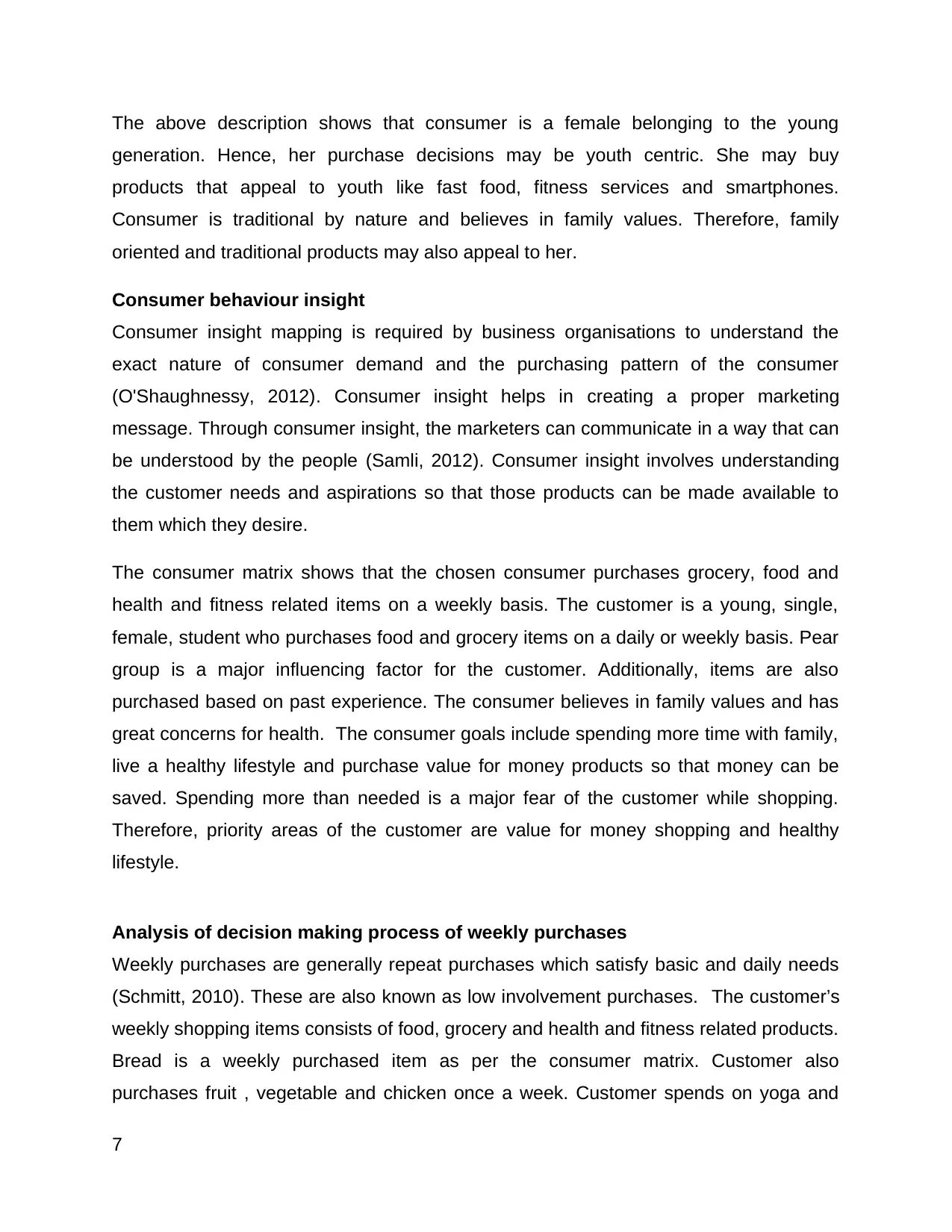
The above description shows that consumer is a female belonging to the young
generation. Hence, her purchase decisions may be youth centric. She may buy
products that appeal to youth like fast food, fitness services and smartphones.
Consumer is traditional by nature and believes in family values. Therefore, family
oriented and traditional products may also appeal to her.
Consumer behaviour insight
Consumer insight mapping is required by business organisations to understand the
exact nature of consumer demand and the purchasing pattern of the consumer
(O'Shaughnessy, 2012). Consumer insight helps in creating a proper marketing
message. Through consumer insight, the marketers can communicate in a way that can
be understood by the people (Samli, 2012). Consumer insight involves understanding
the customer needs and aspirations so that those products can be made available to
them which they desire.
The consumer matrix shows that the chosen consumer purchases grocery, food and
health and fitness related items on a weekly basis. The customer is a young, single,
female, student who purchases food and grocery items on a daily or weekly basis. Pear
group is a major influencing factor for the customer. Additionally, items are also
purchased based on past experience. The consumer believes in family values and has
great concerns for health. The consumer goals include spending more time with family,
live a healthy lifestyle and purchase value for money products so that money can be
saved. Spending more than needed is a major fear of the customer while shopping.
Therefore, priority areas of the customer are value for money shopping and healthy
lifestyle.
Analysis of decision making process of weekly purchases
Weekly purchases are generally repeat purchases which satisfy basic and daily needs
(Schmitt, 2010). These are also known as low involvement purchases. The customer’s
weekly shopping items consists of food, grocery and health and fitness related products.
Bread is a weekly purchased item as per the consumer matrix. Customer also
purchases fruit , vegetable and chicken once a week. Customer spends on yoga and
7
generation. Hence, her purchase decisions may be youth centric. She may buy
products that appeal to youth like fast food, fitness services and smartphones.
Consumer is traditional by nature and believes in family values. Therefore, family
oriented and traditional products may also appeal to her.
Consumer behaviour insight
Consumer insight mapping is required by business organisations to understand the
exact nature of consumer demand and the purchasing pattern of the consumer
(O'Shaughnessy, 2012). Consumer insight helps in creating a proper marketing
message. Through consumer insight, the marketers can communicate in a way that can
be understood by the people (Samli, 2012). Consumer insight involves understanding
the customer needs and aspirations so that those products can be made available to
them which they desire.
The consumer matrix shows that the chosen consumer purchases grocery, food and
health and fitness related items on a weekly basis. The customer is a young, single,
female, student who purchases food and grocery items on a daily or weekly basis. Pear
group is a major influencing factor for the customer. Additionally, items are also
purchased based on past experience. The consumer believes in family values and has
great concerns for health. The consumer goals include spending more time with family,
live a healthy lifestyle and purchase value for money products so that money can be
saved. Spending more than needed is a major fear of the customer while shopping.
Therefore, priority areas of the customer are value for money shopping and healthy
lifestyle.
Analysis of decision making process of weekly purchases
Weekly purchases are generally repeat purchases which satisfy basic and daily needs
(Schmitt, 2010). These are also known as low involvement purchases. The customer’s
weekly shopping items consists of food, grocery and health and fitness related products.
Bread is a weekly purchased item as per the consumer matrix. Customer also
purchases fruit , vegetable and chicken once a week. Customer spends on yoga and
7
Paraphrase This Document
Need a fresh take? Get an instant paraphrase of this document with our AI Paraphraser
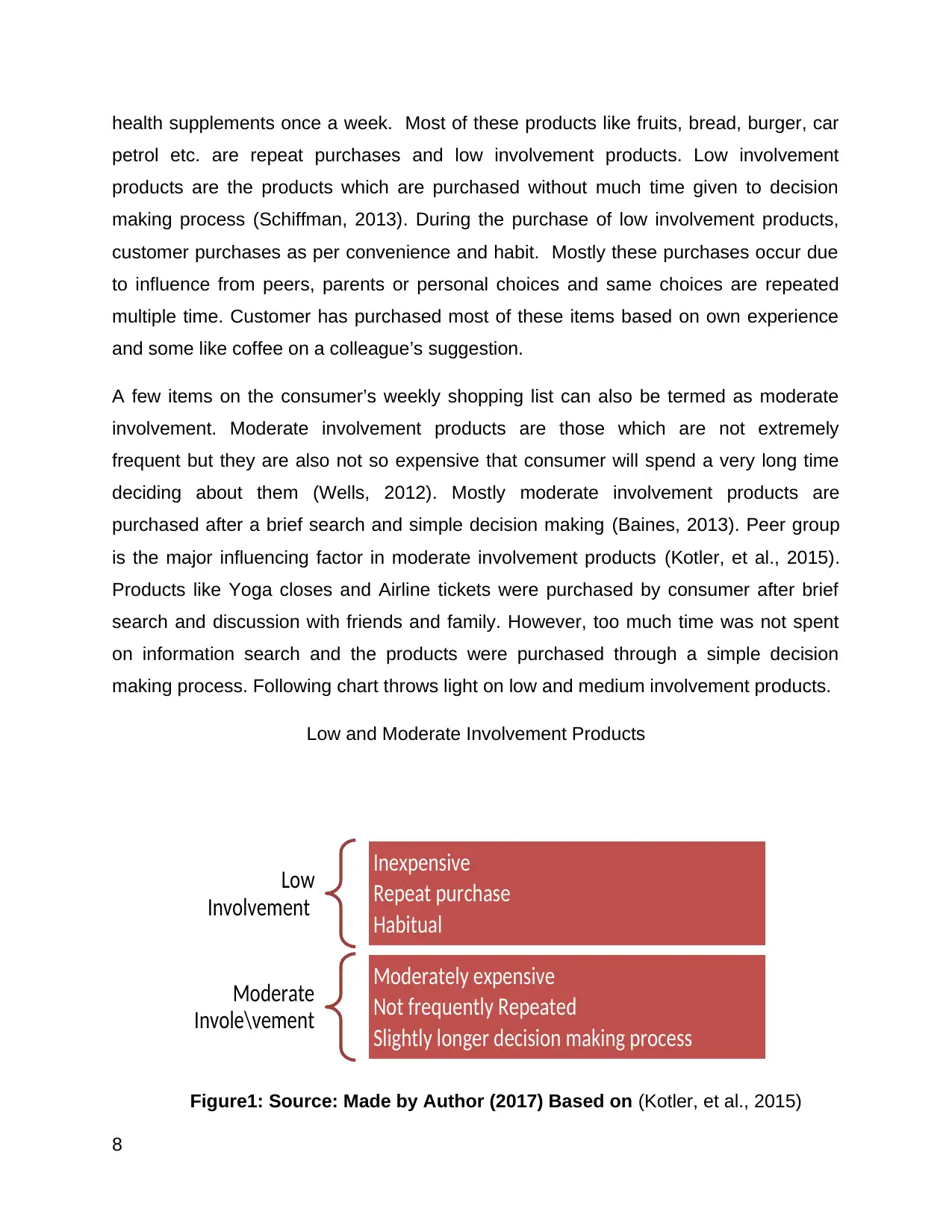
health supplements once a week. Most of these products like fruits, bread, burger, car
petrol etc. are repeat purchases and low involvement products. Low involvement
products are the products which are purchased without much time given to decision
making process (Schiffman, 2013). During the purchase of low involvement products,
customer purchases as per convenience and habit. Mostly these purchases occur due
to influence from peers, parents or personal choices and same choices are repeated
multiple time. Customer has purchased most of these items based on own experience
and some like coffee on a colleague’s suggestion.
A few items on the consumer’s weekly shopping list can also be termed as moderate
involvement. Moderate involvement products are those which are not extremely
frequent but they are also not so expensive that consumer will spend a very long time
deciding about them (Wells, 2012). Mostly moderate involvement products are
purchased after a brief search and simple decision making (Baines, 2013). Peer group
is the major influencing factor in moderate involvement products (Kotler, et al., 2015).
Products like Yoga closes and Airline tickets were purchased by consumer after brief
search and discussion with friends and family. However, too much time was not spent
on information search and the products were purchased through a simple decision
making process. Following chart throws light on low and medium involvement products.
Low and Moderate Involvement Products
Figure1: Source: Made by Author (2017) Based on (Kotler, et al., 2015)
8
Low
Involvement
Inexpensive
Repeat purchase
Habitual
Moderate
Invole\vement
Moderately expensive
Not frequently Repeated
Slightly longer decision making process
petrol etc. are repeat purchases and low involvement products. Low involvement
products are the products which are purchased without much time given to decision
making process (Schiffman, 2013). During the purchase of low involvement products,
customer purchases as per convenience and habit. Mostly these purchases occur due
to influence from peers, parents or personal choices and same choices are repeated
multiple time. Customer has purchased most of these items based on own experience
and some like coffee on a colleague’s suggestion.
A few items on the consumer’s weekly shopping list can also be termed as moderate
involvement. Moderate involvement products are those which are not extremely
frequent but they are also not so expensive that consumer will spend a very long time
deciding about them (Wells, 2012). Mostly moderate involvement products are
purchased after a brief search and simple decision making (Baines, 2013). Peer group
is the major influencing factor in moderate involvement products (Kotler, et al., 2015).
Products like Yoga closes and Airline tickets were purchased by consumer after brief
search and discussion with friends and family. However, too much time was not spent
on information search and the products were purchased through a simple decision
making process. Following chart throws light on low and medium involvement products.
Low and Moderate Involvement Products
Figure1: Source: Made by Author (2017) Based on (Kotler, et al., 2015)
8
Low
Involvement
Inexpensive
Repeat purchase
Habitual
Moderate
Invole\vement
Moderately expensive
Not frequently Repeated
Slightly longer decision making process
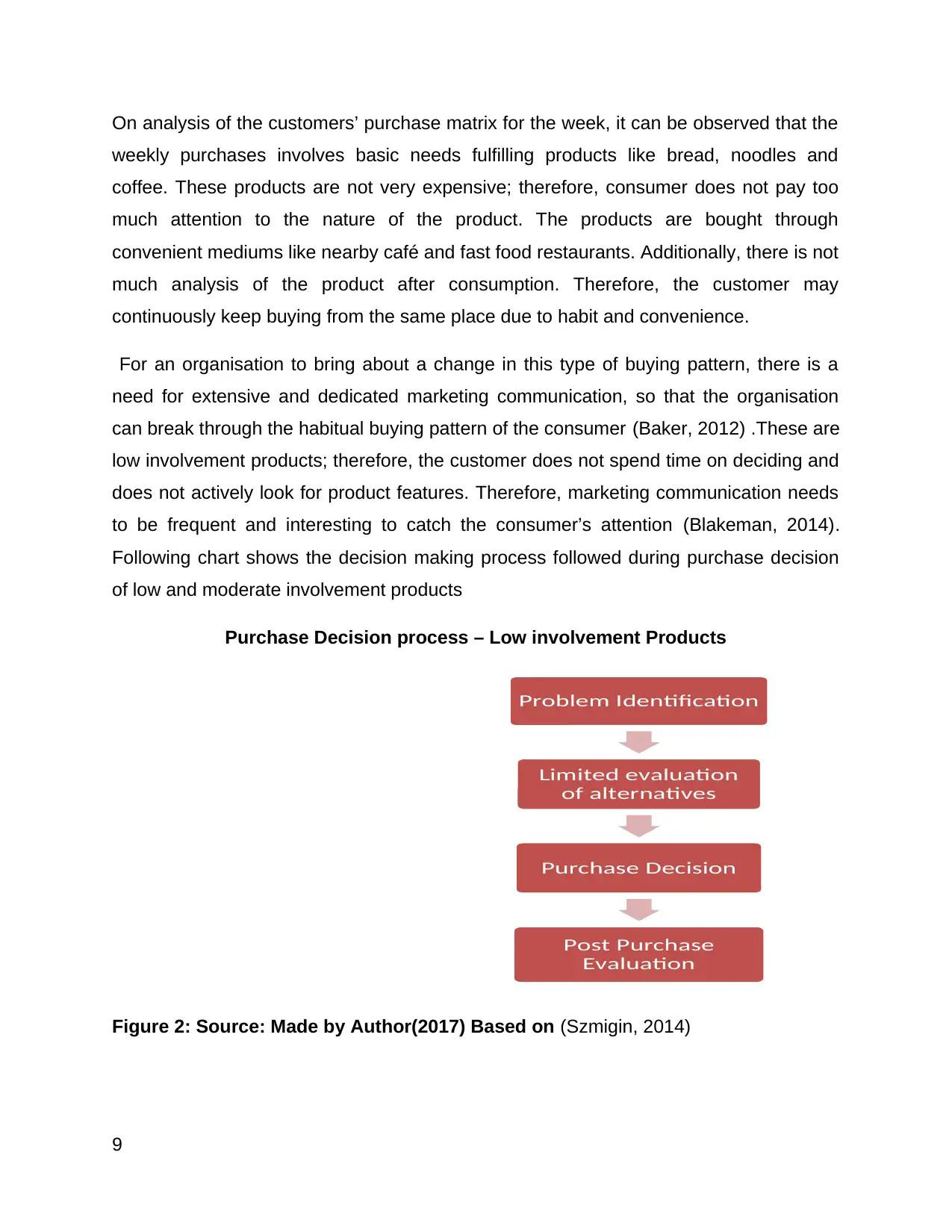
On analysis of the customers’ purchase matrix for the week, it can be observed that the
weekly purchases involves basic needs fulfilling products like bread, noodles and
coffee. These products are not very expensive; therefore, consumer does not pay too
much attention to the nature of the product. The products are bought through
convenient mediums like nearby café and fast food restaurants. Additionally, there is not
much analysis of the product after consumption. Therefore, the customer may
continuously keep buying from the same place due to habit and convenience.
For an organisation to bring about a change in this type of buying pattern, there is a
need for extensive and dedicated marketing communication, so that the organisation
can break through the habitual buying pattern of the consumer (Baker, 2012) .These are
low involvement products; therefore, the customer does not spend time on deciding and
does not actively look for product features. Therefore, marketing communication needs
to be frequent and interesting to catch the consumer’s attention (Blakeman, 2014).
Following chart shows the decision making process followed during purchase decision
of low and moderate involvement products
Purchase Decision process – Low involvement Products
Figure 2: Source: Made by Author(2017) Based on (Szmigin, 2014)
9
Problem Identification
Limited evaluation
of alternatives
Purchase Decision
Post Purchase
Evaluation
weekly purchases involves basic needs fulfilling products like bread, noodles and
coffee. These products are not very expensive; therefore, consumer does not pay too
much attention to the nature of the product. The products are bought through
convenient mediums like nearby café and fast food restaurants. Additionally, there is not
much analysis of the product after consumption. Therefore, the customer may
continuously keep buying from the same place due to habit and convenience.
For an organisation to bring about a change in this type of buying pattern, there is a
need for extensive and dedicated marketing communication, so that the organisation
can break through the habitual buying pattern of the consumer (Baker, 2012) .These are
low involvement products; therefore, the customer does not spend time on deciding and
does not actively look for product features. Therefore, marketing communication needs
to be frequent and interesting to catch the consumer’s attention (Blakeman, 2014).
Following chart shows the decision making process followed during purchase decision
of low and moderate involvement products
Purchase Decision process – Low involvement Products
Figure 2: Source: Made by Author(2017) Based on (Szmigin, 2014)
9
Problem Identification
Limited evaluation
of alternatives
Purchase Decision
Post Purchase
Evaluation
⊘ This is a preview!⊘
Do you want full access?
Subscribe today to unlock all pages.

Trusted by 1+ million students worldwide
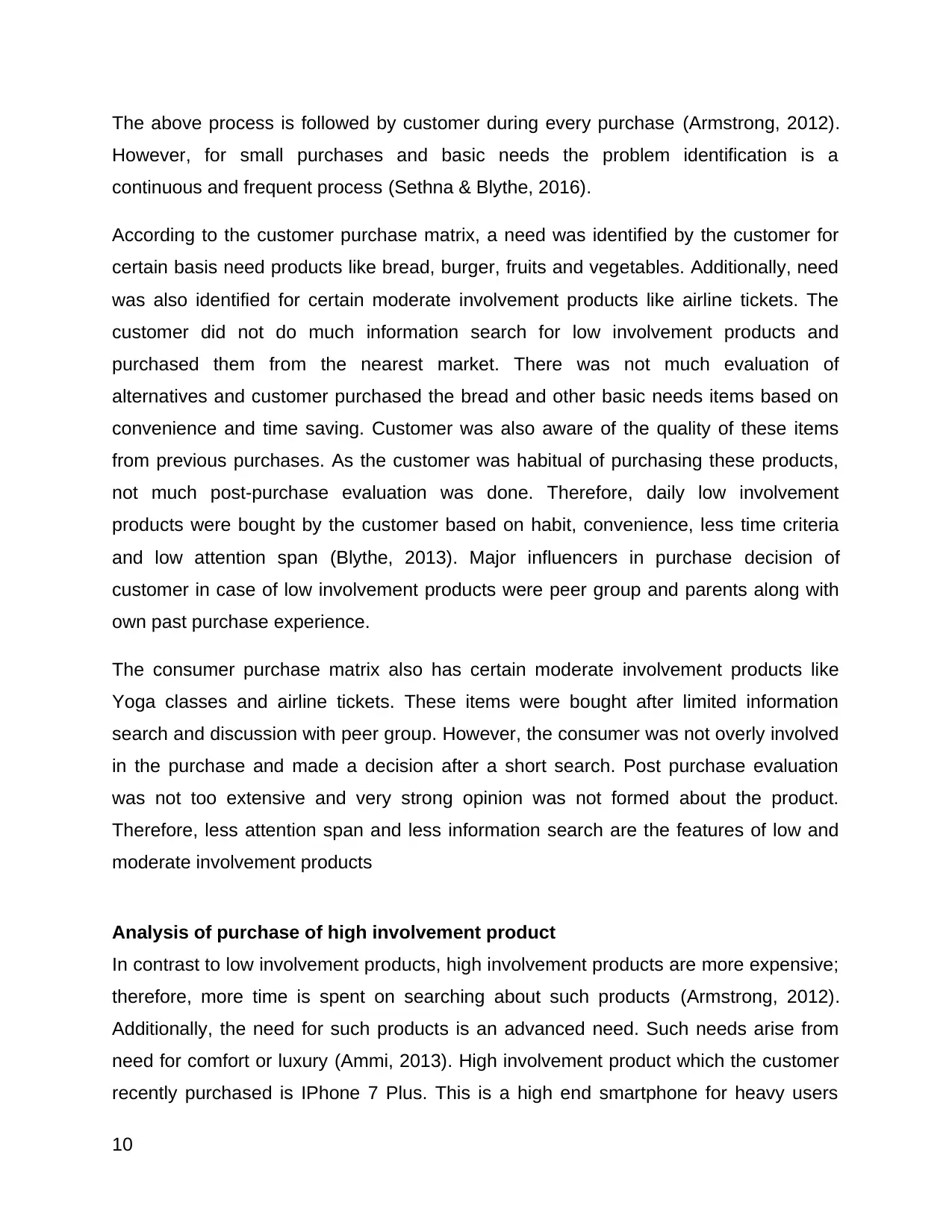
The above process is followed by customer during every purchase (Armstrong, 2012).
However, for small purchases and basic needs the problem identification is a
continuous and frequent process (Sethna & Blythe, 2016).
According to the customer purchase matrix, a need was identified by the customer for
certain basis need products like bread, burger, fruits and vegetables. Additionally, need
was also identified for certain moderate involvement products like airline tickets. The
customer did not do much information search for low involvement products and
purchased them from the nearest market. There was not much evaluation of
alternatives and customer purchased the bread and other basic needs items based on
convenience and time saving. Customer was also aware of the quality of these items
from previous purchases. As the customer was habitual of purchasing these products,
not much post-purchase evaluation was done. Therefore, daily low involvement
products were bought by the customer based on habit, convenience, less time criteria
and low attention span (Blythe, 2013). Major influencers in purchase decision of
customer in case of low involvement products were peer group and parents along with
own past purchase experience.
The consumer purchase matrix also has certain moderate involvement products like
Yoga classes and airline tickets. These items were bought after limited information
search and discussion with peer group. However, the consumer was not overly involved
in the purchase and made a decision after a short search. Post purchase evaluation
was not too extensive and very strong opinion was not formed about the product.
Therefore, less attention span and less information search are the features of low and
moderate involvement products
Analysis of purchase of high involvement product
In contrast to low involvement products, high involvement products are more expensive;
therefore, more time is spent on searching about such products (Armstrong, 2012).
Additionally, the need for such products is an advanced need. Such needs arise from
need for comfort or luxury (Ammi, 2013). High involvement product which the customer
recently purchased is IPhone 7 Plus. This is a high end smartphone for heavy users
10
However, for small purchases and basic needs the problem identification is a
continuous and frequent process (Sethna & Blythe, 2016).
According to the customer purchase matrix, a need was identified by the customer for
certain basis need products like bread, burger, fruits and vegetables. Additionally, need
was also identified for certain moderate involvement products like airline tickets. The
customer did not do much information search for low involvement products and
purchased them from the nearest market. There was not much evaluation of
alternatives and customer purchased the bread and other basic needs items based on
convenience and time saving. Customer was also aware of the quality of these items
from previous purchases. As the customer was habitual of purchasing these products,
not much post-purchase evaluation was done. Therefore, daily low involvement
products were bought by the customer based on habit, convenience, less time criteria
and low attention span (Blythe, 2013). Major influencers in purchase decision of
customer in case of low involvement products were peer group and parents along with
own past purchase experience.
The consumer purchase matrix also has certain moderate involvement products like
Yoga classes and airline tickets. These items were bought after limited information
search and discussion with peer group. However, the consumer was not overly involved
in the purchase and made a decision after a short search. Post purchase evaluation
was not too extensive and very strong opinion was not formed about the product.
Therefore, less attention span and less information search are the features of low and
moderate involvement products
Analysis of purchase of high involvement product
In contrast to low involvement products, high involvement products are more expensive;
therefore, more time is spent on searching about such products (Armstrong, 2012).
Additionally, the need for such products is an advanced need. Such needs arise from
need for comfort or luxury (Ammi, 2013). High involvement product which the customer
recently purchased is IPhone 7 Plus. This is a high end smartphone for heavy users
10
Paraphrase This Document
Need a fresh take? Get an instant paraphrase of this document with our AI Paraphraser
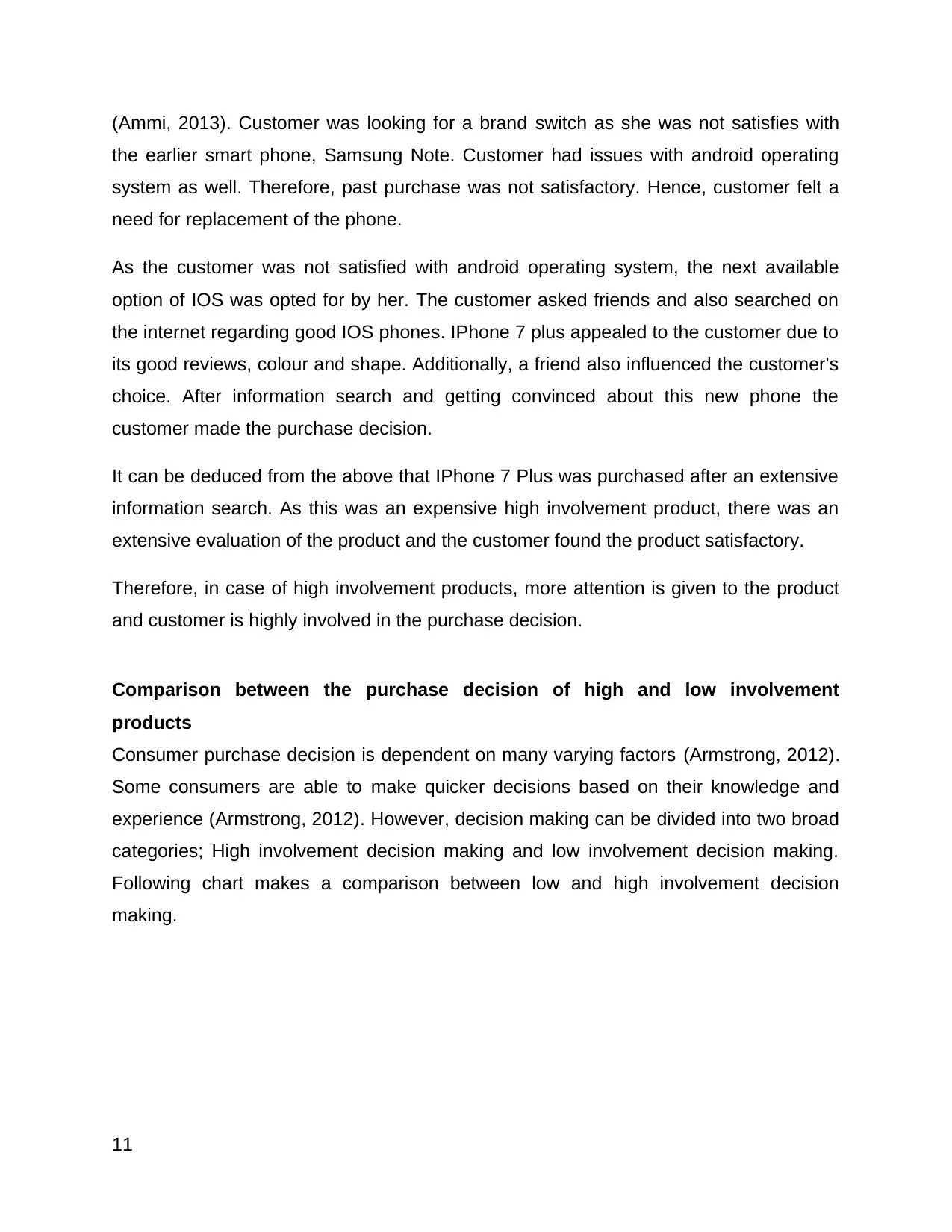
(Ammi, 2013). Customer was looking for a brand switch as she was not satisfies with
the earlier smart phone, Samsung Note. Customer had issues with android operating
system as well. Therefore, past purchase was not satisfactory. Hence, customer felt a
need for replacement of the phone.
As the customer was not satisfied with android operating system, the next available
option of IOS was opted for by her. The customer asked friends and also searched on
the internet regarding good IOS phones. IPhone 7 plus appealed to the customer due to
its good reviews, colour and shape. Additionally, a friend also influenced the customer’s
choice. After information search and getting convinced about this new phone the
customer made the purchase decision.
It can be deduced from the above that IPhone 7 Plus was purchased after an extensive
information search. As this was an expensive high involvement product, there was an
extensive evaluation of the product and the customer found the product satisfactory.
Therefore, in case of high involvement products, more attention is given to the product
and customer is highly involved in the purchase decision.
Comparison between the purchase decision of high and low involvement
products
Consumer purchase decision is dependent on many varying factors (Armstrong, 2012).
Some consumers are able to make quicker decisions based on their knowledge and
experience (Armstrong, 2012). However, decision making can be divided into two broad
categories; High involvement decision making and low involvement decision making.
Following chart makes a comparison between low and high involvement decision
making.
11
the earlier smart phone, Samsung Note. Customer had issues with android operating
system as well. Therefore, past purchase was not satisfactory. Hence, customer felt a
need for replacement of the phone.
As the customer was not satisfied with android operating system, the next available
option of IOS was opted for by her. The customer asked friends and also searched on
the internet regarding good IOS phones. IPhone 7 plus appealed to the customer due to
its good reviews, colour and shape. Additionally, a friend also influenced the customer’s
choice. After information search and getting convinced about this new phone the
customer made the purchase decision.
It can be deduced from the above that IPhone 7 Plus was purchased after an extensive
information search. As this was an expensive high involvement product, there was an
extensive evaluation of the product and the customer found the product satisfactory.
Therefore, in case of high involvement products, more attention is given to the product
and customer is highly involved in the purchase decision.
Comparison between the purchase decision of high and low involvement
products
Consumer purchase decision is dependent on many varying factors (Armstrong, 2012).
Some consumers are able to make quicker decisions based on their knowledge and
experience (Armstrong, 2012). However, decision making can be divided into two broad
categories; High involvement decision making and low involvement decision making.
Following chart makes a comparison between low and high involvement decision
making.
11
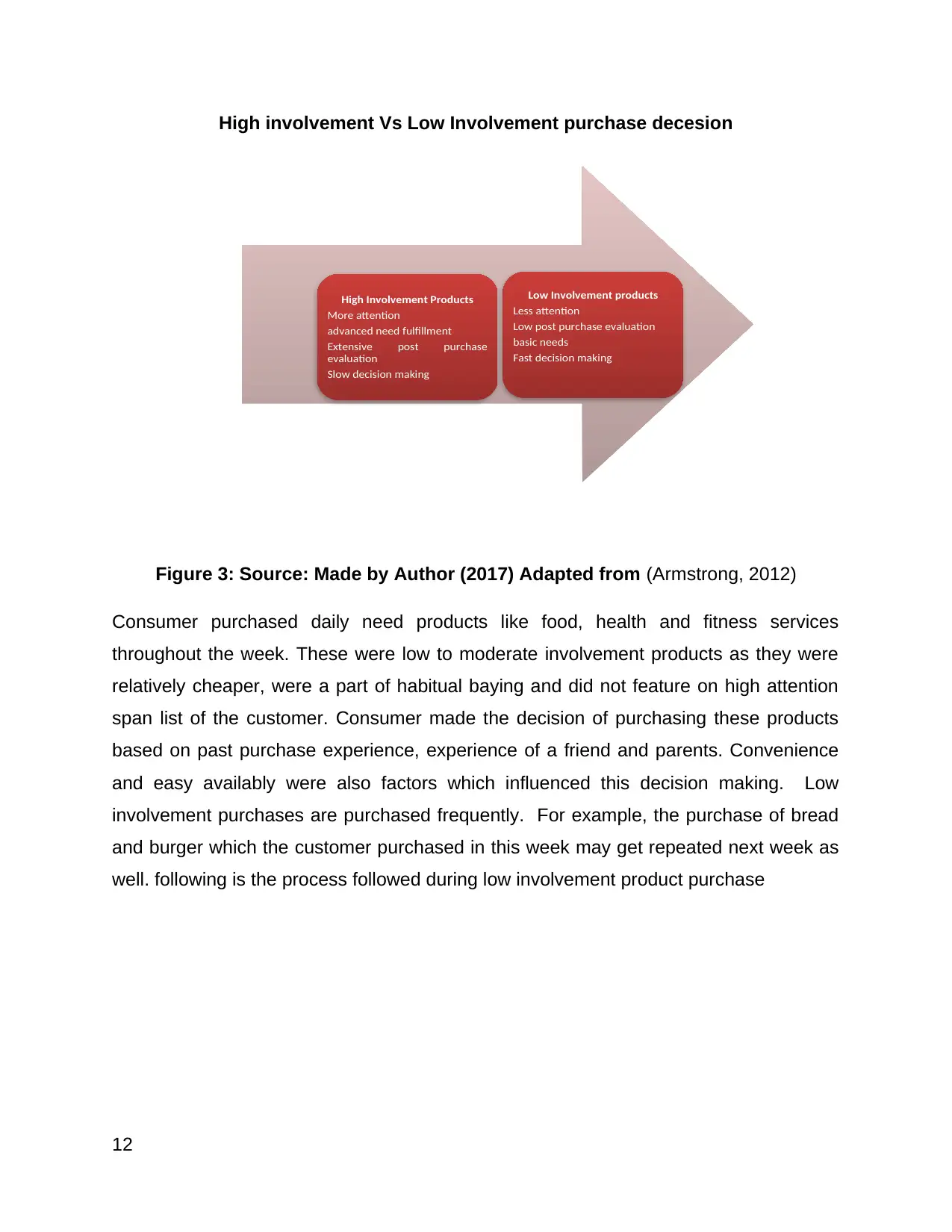
High involvement Vs Low Involvement purchase decesion
Figure 3: Source: Made by Author (2017) Adapted from (Armstrong, 2012)
Consumer purchased daily need products like food, health and fitness services
throughout the week. These were low to moderate involvement products as they were
relatively cheaper, were a part of habitual baying and did not feature on high attention
span list of the customer. Consumer made the decision of purchasing these products
based on past purchase experience, experience of a friend and parents. Convenience
and easy availably were also factors which influenced this decision making. Low
involvement purchases are purchased frequently. For example, the purchase of bread
and burger which the customer purchased in this week may get repeated next week as
well. following is the process followed during low involvement product purchase
12
High Involvement Products
More attention
advanced need fulfillment
Extensive post purchase
evaluation
Slow decision making
Low Involvement products
Less attention
Low post purchase evaluation
basic needs
Fast decision making
Figure 3: Source: Made by Author (2017) Adapted from (Armstrong, 2012)
Consumer purchased daily need products like food, health and fitness services
throughout the week. These were low to moderate involvement products as they were
relatively cheaper, were a part of habitual baying and did not feature on high attention
span list of the customer. Consumer made the decision of purchasing these products
based on past purchase experience, experience of a friend and parents. Convenience
and easy availably were also factors which influenced this decision making. Low
involvement purchases are purchased frequently. For example, the purchase of bread
and burger which the customer purchased in this week may get repeated next week as
well. following is the process followed during low involvement product purchase
12
High Involvement Products
More attention
advanced need fulfillment
Extensive post purchase
evaluation
Slow decision making
Low Involvement products
Less attention
Low post purchase evaluation
basic needs
Fast decision making
⊘ This is a preview!⊘
Do you want full access?
Subscribe today to unlock all pages.

Trusted by 1+ million students worldwide
1 out of 18
Related Documents
Your All-in-One AI-Powered Toolkit for Academic Success.
+13062052269
info@desklib.com
Available 24*7 on WhatsApp / Email
![[object Object]](/_next/static/media/star-bottom.7253800d.svg)
Unlock your academic potential
Copyright © 2020–2025 A2Z Services. All Rights Reserved. Developed and managed by ZUCOL.





